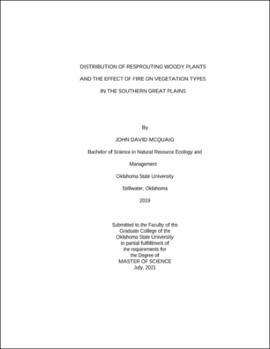| dc.description.abstract | The effects of soil, topography, and fire on woody plant distribution and extent has been studied over numerous systems; however, most literature has focused individually on these influencing variables at single sites. In this study, we evaluated the effects of soil texture, slope, aspect, and fire measured across 39 ecological sites and four different locations in Oklahoma, USA, from 2018-2019. We used an information€ theoretic model building approach to develop models describing the effects of these predictor variables on two different estimates of woody plant cover as well as woody plant density across sites. Top models for all three woody plant metrics indicated that both woody plant cover and density were primarily influenced by percent sand, aspect direction, and the number of times burned. Metrics of woody plant cover and density declined in areas with finer soil textures, east-facing aspects, and areas that were burned more frequently across sites. Of these predictor variables, topoedaphic variables appeared overall to have a greater influence than fire. This suggests that managing woody plants with fire is partly limited by underlying soil and topographic conditions. Summary statistics at the site level mostly indicated relationships similar to cross-site analysis among woody plant metrics and predictor variables, however, there were also differences among sites. In addition to examining broad-scale patterns, we also investigated site-level relationships. Specifically, we examined the post-fire effects on woody plant vegetation type at three of the four sites. Our research suggests that these vegetation types of the Southern Great Plains recover quickly from fire and can be burned every 2-3 years to promote heterogeneity, limit the invasion of non-resprouting woody plants, and potentially benefit native wildlife. Following fire, vegetation cover and structure recovered to pre-burn conditions within 2 years post-fire at all three sites. Our research emphasizes the importance of broad-scale and site-level examination of woody plant distribution to better understand the factors influencing woody plant cover and densities to provide insightful management strategies for these landscapes. | |
